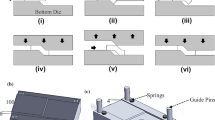Abstract
A concave R-curve for an AlMgZn alloy covers the transition from fully flat to fully slant fracture in 25 mm thick specimens of varying geometry. The transition is associated with the onset of plane stress conditions near the crack front. The concave R-curve is analysed using the increasing width of the shear lips, as in the Krafft et al. model, which increased the plastic work parabolically. The elastic and plastic work rates are evaluated using parabolic curve fits to the R-curve data. The present study showed that the plastic work rate scales with the crack extension from fully flat to fully slant fracture, which is geometry dependent
Similar content being viewed by others
References
Cheung, S. and Luxmoore, A.R. (2002a). The Interaction of T-stresses and R-curves. Fatigue and Fracture of Engineering Materials and Structures (submitted).
Cheung, S. and Luxmoore, A.R. (2002b). A finite element analysis of stable crack growth in an aluminium alloy. Engineering Fracture Mechanics (in press).
Gibson, G.P., Druce, S.G. and Turner, C.E. (1988). Effect of specimen size and geometry on ductile crack growth resistance in a C-Mn steel. International Journal of Fracture 37, 83–100.
Green, G. and Knott, J.F. (1975). On effects of thickness on ductile crack growth in mild steel. Journal of the Mechanics and Physics of Solids 23, 167–183.
Henry, B.S. and Luxmoore, A.R. (1996). Two-parameter fracture assessment of through-thickness cracks in an aluminium bridge structure. Eleventh European Conference on Fracture, ECF-11, Futuroscope, France.
Henry, B.S., Luxmoore, A.R. and Sumpter, J.D.G. (1996). Elastic-plastic fracture mechanics assessment of low constraint aluminium test specimens. International Journal of Fracture 81, 217–234.
Krafft, J.M., Sullivan, A.M. and Boyle, R.W. (1962). Effect of dimensions on fast fracture instability of notched sheets. Proceedings of the Crack Propagation Symposium Cranfield, Vol. 1. The College of Aeronautics, 8–28.
Mai, Y.W., Atkins, A.G. and Caddell, R.M. (1976). Determination of valid R-curves for materials with large fracture toughness to yield strength ratios. International Journal of Fracture 12, 391–407.
Sumpter, J.D.G. (1996). Observations on tearing instability in an aluminium alloy. Mechanisms and Mechanics of Damage and Failure, ECF-11 2, 855–860.
Sumpter, J.D.G. (2000). Fracture and Fatigue Testing of a 7019 Aluminium Bridge Extrusion, Report DERA/MSS/MSTR1/TR000504, Defence Evaluation and Research Agency UK, August 2000.
Turner, C.E. and Braga, L. (1993). Energy dissipation rate and crack opening angle analyses of fully plastic ductile tearing. Constraint effects in fracture. ASTM STP 1171, 158–175.
Author information
Authors and Affiliations
Rights and permissions
About this article
Cite this article
Cheung, S., Luxmoore, A. A shear lip analysis of concave R-curves for an AlMgZn alloy. International Journal of Fracture 117, 195–205 (2002). https://doi.org/10.1023/A:1022050618899
Issue Date:
DOI: https://doi.org/10.1023/A:1022050618899




